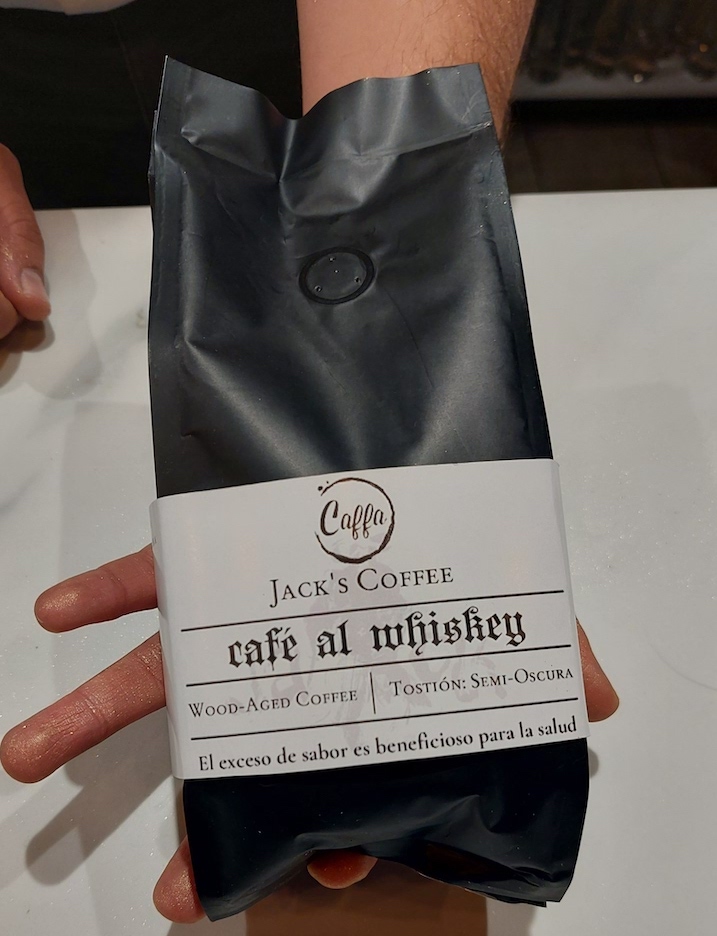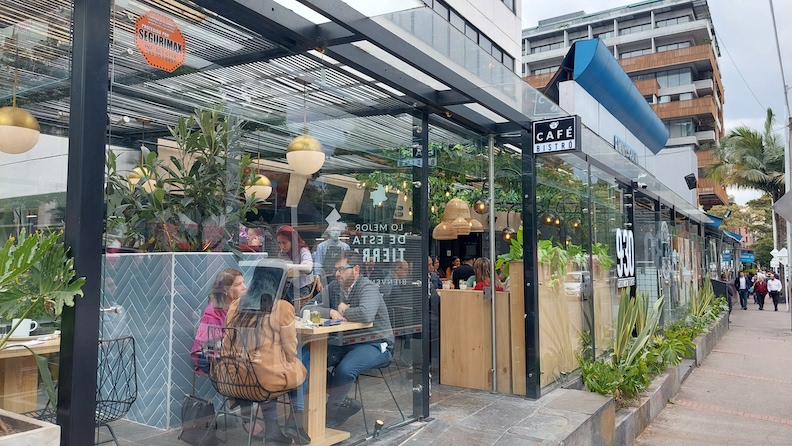
Juan Felipe Lozano with two servers in Caffa Colombia, a specialty coffee café in Bogotá’s upscale El Chicó neighborhood. Photo by Richard Varr
By Richard Varr
Boiling water shoots through a glass flask and into an upper chamber that resembles a flask you might see in a chemistry lab. The water mixes with crushed Colombia coffee beans and begins to percolate. The complex beverage that soon will emerge represents coffee’s “fourth wave” movement.
“We are brewing an amazing coffee that will have a dark chocolate flavor,” says Juan Felipe Lozano, a professional Colombian coffee taster who, for this particular brew, is using the so-called Japanese Siphon method. “This process puts a lot of pressure on the coffee beans,” he explains. “True, I’m losing the most subtle flavors, but in return, I’m extracting stronger flavors.”
Enticing aromas waft through Caffa Colombia, Lozano’s coffee store and café, located in Bogotá’s fashionably upscale El Chicó neighborhood. Caffa is one of three cafes I will visit this morning with Lozano, a barista whom I soon regard as a 21st-century Juan Valdez. But Lozano is more than a product pitchman. Indeed, he is a guide to the specialty flavors now emerging in one of the world’s most famous coffee-producing countries.
Lozano extinguishes the alcohol burner under the flask, and as the temperature cools, the reverse pressure sucks the water back into the lower flask. “Instead of just gravity, this suction will pull the water through the ground coffee extracting flavors that normally would remain hidden.” In this brew, essences of hazelnut and cinnamon appear along with notes of tangerine and mandarin.
The freshly brewed concoction reveals a smooth and creamy taste, like milk has been added. “But it has not,” he points out. “This is because of the coffee and the method we used, making it full-bodied and thick. Specialty coffee should be so good that even a non-coffee drinker can perceive flavors in it.”
The Mile-High Beverage
This coffee Lozano brewed for my visit comes from Arboledas, a small town in a mountainous area of Colombia’s North Santander department bordering Venezuela. And why is it called specialty? Because specialty coffee usually is grown on individual farms in unique microclimates at high altitudes and sold directly to coffee roasters and brewers. “I personally consider exotic coffee as no more than three percent of the production in a specific region,” says Lozano.

Juan Felipe Lozano uses the Japanese Siphon method to brew specialty coffee grown in high altitudes in Arboledas, Colombia. Suction from the heating process extracts flavors from the ground coffee missed by gravity alone. The resulting brew is creamy with flavors including hazelnut and cinnamon and notes of mandarin. Photo by Richard Varr
“Arboledas is a beautiful place that was ravaged by war. This coffee is crazy good, but people never tried it because of the armed conflict,” he continues. “Thanks to the peace process, we’re able to go there today. And we wonder how this coffee – an amazing coffee – has eluded us, like a hidden jewel.”
Arboledas coffee plants grow at 1,420 meters altitude (4,660 ft), says Lozano, noting higher altitudes tend to yield more complex flavors. Before brewing, the dry coffee has a rich and strong aroma bursting through the air. “It’s sweet, but also bitter and fruity. That’s a complex coffee,” says Lozano. As a comparison, I take a few whiffs of the much duller fragrance of typical supermarket coffee that he pours in another vessel to show the stark differences.
Lozano touts his country as a leader in coffee’s fourth wave, calling it a movement that combines innovation in brewing based on indigenous culture while creating beverages from local ingredients. “As a professional coffee taster and consultant, I am able to go to coffee fields and select the coffee myself,” he says.
There are different interpretations, but broadly defined, the first coffee wave dates to the second half of the 19th Century when coffee was more of a commodity purchased in bulk and featured such names as Maxwell House and Folgers. The second wave took root in the 1970s when Starbucks brewed better quality coffee and created a social café culture. That evolved into the third wave, where discerning consumers wanted a cup of java that suited their tastes with more attention to where the beans are grown, and its distinct flavors and sustainability. Today this is recognized as the specialty coffee movement. The fourth wave takes it a step further, seeking out specialty farmers, a more scientific approach to brewing and more experimentation with added flavors.

Servers in the Érase una Vez café in Bogotá proudly serve coffee from the mountainous department of Cauca. Instead of delivering the coffee in a pot or bringing it in cups, the coffee is prepared at the table by pouring hot water through a filter. The immediacy of preparation allows the customer to smell the coffee’s sweet aroma. Photo by Richard Varr
Worldwide Coffee Economy
Colombia may be leading coffee’s fourth wave agriculturally, but coffee’s economic boom is best seen in North America and China. A recent Wall Street Journal report highlights how investors with Starbucks’ stock have earned 300 times their initial investment. Indeed, one in ten Americans are members of the Starbucks Rewards loyalty program. Smaller chains like Dunkin’ Donuts, Tim Hortons, and Dutch Bros also have joined the bandwagon.
Despite the average Chinese only consuming 12 cups of coffee per year (vs. 380 in the U.S.), Starbucks believes China is key to its drive to increase its worldwide store count from 37,000 today to 55,000 by 2030. Starbucks has 6,500 stores in China now but has vowed to open a new store every nine hours over the coming three years.
Starbucks faces competition from China-based Luckin Coffee, which hopes to soon double its existing chain of 5,000 Cotti Coffee stores. Coming up fast are KFC and McDonald’s, two highly competitive sellers of java with Chinese restaurants numbering about 9,200 and 2,500, respectively.
While chains like Starbucks offer different roasts and flavors, specialty brewers like Lozano handpick their own coffee beans from unique local coffee farms and create their own concoctions.
Bogotá’s Bourbon Brew

Coffee aged in Jack Daniel’s whiskey oak barrels sold at Juan Felipe Lozano’s Caffa Colombia café and coffee store in Bogotá. This coffee has notes of whiskey, caramel and wood, and is used to brew the café’s specialty coffee “El Dorado.” Photo by Richard Varr
Lozano’s most distinctive one blends espresso matured in whiskey oak barrels, Colombian cocoa and vanilla ice cream with traditional Colombian panela made from sugarcane juice. He then adds steamed almond milk which he says brings out the oak barrel flavor and tops it off with a glittering consumption-grade gold leaf flake. “This is very fourth wave,” he insists. “This coffee is called ‘El Dorado’ or ‘The Golden.’ It refers to the legend of a city made of gold here in Colombia. It’s an opportunity to try a coffee with literal gold.”
A few blocks beyond Caffa Colombia is the El Chicó neighborhood’s central Parque 93, a grassy rectangular area shaded by palm trees arrayed about a giant red “LOVE” sculpture similar to the one in John F. Kennedy Plaza in Philadelphia. The 9.30 Café serves coffee from Armenia, the capital of the Quindio department in Colombia’s traditional Coffee Triangle region. After placing our order on the table, the server explains that this brew has very subtle red wine and fruity orange peel flavors from coffee beans grown at 1,800 meters or almost 6,000 ft. Anything above 1,600 meters is considered high-altitude coffee, according to Lozano.
“The higher the altitude, the less oxygen which means the more lactic acid production in the cherry,” he explains, using the name given to the coffee bean. “Lactic acid is important in coffee because it develops complex flavors. But it doesn’t mean lower altitude coffee will not have complex flavors.”

The 9.30 Café in Bogotá’s El Chicó neighborhood serves coffee from Armenia, the capital of the Quindio department in Colombia’s traditional Coffee Triangle region. The brew has very subtle red wine and fruity orange peel flavors from coffee beans grown at almost 6,000 feet. High altitude coffee produces complex flavors. Photo by Richard Varr
Easy as Baking a Cake
Earlier, we stopped at a third café named Érase una Vez (translated to Once Upon a Time) in Bogotá’s Quinta Paredes neighborhood near Coferias, a convention center. This time, a pour-over process is used in front of us with coffee from the department of Cauca along the Pacific Ocean. The server measures a precise 1:16 ratio of 24 grams of ground coffee and 380 milliliters of water. “It’s like cooking,” explains Lozano. “When you’re baking a cake, you need to have the exact amount of eggs, butter and water.”
The process quickly releases a sweet aroma resulting in a caramel color brew with orange tones on the edges. “One of the first ways to recognize a specialty coffee is with the first drops of water,” says Lozano. “If the room doesn’t fill with aroma, it’s not specialty coffee or at least fresh coffee.”
After several sips, the coffee’s stronger flavor is paramount, but not the sweetness I had expected. “That’s OK,” says Lozano. “A complex coffee will smell like something when it’s dry, like something else when it’s wet, and can also taste like something else.” This coffee has a citrus flavor and bitterness. “So, I wouldn’t say it’s orange flavor, but instead orange peel flavor.”

Juan Felipe Lozano’s specialty coffee he calls “El Dorado” is made from espresso matured in Jack Daniel’s whiskey oak barrels, Colombian cocoa and vanilla ice cream with traditional Colombian panela made from sugarcane juice. It’s topped off with steamed almond milk and an edible gold leaf flake. “This is very fourth wave,” he says. Photo by Richard Varr
Lozano hails from a family of coffee growers. He grew up in EL Chicó and later attended law school, but instead opted to become an entrepreneur. “I love law, but never pictured myself in a courtroom. My passion is getting to know you and you getting to know me, the stories I tell from the coffee growers and creating new stories. And there’s no salary in the world, no law firm in the world that can give me that.”
“With Caffa,” he continues, “I am proud to say we are one of the ambassadors of the fourth wave here in Colombia. We work with the government, with the Ministry of Culture and the Tourism Institute to show that Bogotá can be and will be the capital of the fourth wave of coffee in the world.”
Richard Varr is a former newspaper journalist who worked as a news reporter and anchor at TV stations in Austin and Houston, Texas. A travel writer for nearly 25 years, he holds more than a dozen SATW writing awards and is the author of the Eyewitness Travel Guide to Philadelphia and the Pennsylvania Dutch Country.

